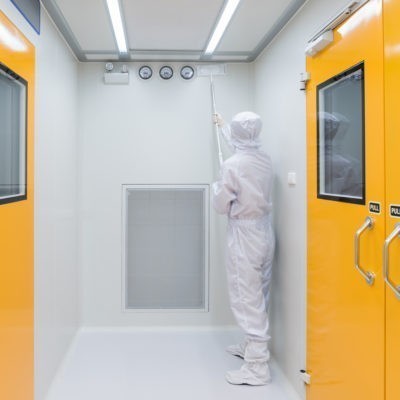You’ve spent the money, taken the time, and exhausted the resources needed to design and construct a perfect cleanroom for your facility’s application. It’s fully operational and exceeding your expectations, so now you can just sit back and enjoy the results, right?
Well, yes — but your work isn’t done. All cleanrooms require constant cleaning because, no matter how robust of a filtration system they may have, they’ll always have some amount of exposure to contaminants.
6 Tips for Cleanroom Cleaning
Regardless of your cleanroom’s ISO classification, adhering to proper cleaning protocols will help ensure its performance and longevity. There are a lot of factors that go into that cleanroom cleaning process, so we’ve compiled a list of six cleaning tips to help you keep track of the most important steps.
1. Choose One of Two Cleanroom Cleaning Methods
For starters, there are two basic methods of cleanroom cleaning that you should be aware of: dry transfer and wet cleaning:
- Dry transfer cleanroom cleaning involves wiping a surface with a collective, absorbent material. This material should be a cleanroom-specified cloth or wipe that won’t shed fibers, break apart, or redeposit contaminant particles. Depending on your cleanroom’s ISO classification, this could include knitted polyester cloths or cotton twill wipes.
- Wet cleanroom cleaning removes contamination with the use of a cleaning fluid. It’s a good choice when dry transfer isn’t enough to overcome particle adhesion to surfaces. However, it’s important to use only cleanroom-specified cleaning agents, such as deionized and distilled water, or neutral, non-ionic, non-foaming chemical solvents.
Most of the time, proper cleanroom cleaning involves both types of cleaning. It’s just important to understand which is best for which kind of surface or application.
2. Be Aware of Varying Industry Standards
Depending on the industry you’re in, your cleanroom will have a unique layout, ISO classification, and cleanliness standard. Your cleaning routine needs to reflect those specifications.
If your cleanroom has a lower ISO classification, it will need to adhere to more regular, comprehensive sanitation processes in order to keep tight control over particulate contamination. Cleanrooms with higher ISO classifications still need to keep up with regular cleanings, but they may be a little less involved.
3. Adhere to Sanitation Protocols Before Entering Your Cleanroom
The best way to keep your cleanroom as clean as possible is to follow proper sanitation protocols before entering it. Make sure all of your equipment and tools are cleaned and disinfected before they’re allowed in.
This step doesn’t just involve equipment though; it also involves your personnel. In fact, they’re usually the biggest contributor of outside contaminants coming into your cleanroom. Ensure all staff members are thoroughly trained on what steps they need to take — from washing and drying hands completely, to using sterile gloves, to following the proper gowning procedure.
4. Implement Advanced Cleaning Equipment As Necessary
In some cases, dry transfer and wet cleaning can only get you so far, and you need to bring in more advanced cleaning technology and equipment. From portable HEPA filtration systems with UV-C light integration, to Dry Hydrogen Peroxide (DHP™), there are many technological cleanroom cleaning innovations to choose from — and they’ll all add a heightened level of filtration or sterilization to your environment.
5. Follow a Top-Down Cleaning Pattern
How you clean is just as important as what you use while cleaning. Although they’re small, contaminant particles are affected by gravitational forces. To ensure any falling particles don’t recontaminate recently cleaned surfaces, you should sanitize your cleanroom from top to bottom, cleaning shelves or work surfaces first and the floor last.
All of which brings up another good tip: don’t forget to sanitize your cleanroom’s floor! The floor is one of the most easily contaminated surfaces of your cleanroom, due to easily-forgotten shoe cleansing and gravity naturally pulling contaminants down. Invest in a shoe cleaner or sticky mat to minimize the number of particles before entering, but also remember to wipe the floor after the fact.
6. Commit to a Regular Cleanroom Cleaning Routine
Maintaining a clean, controlled environment requires diligence. Your team needs to commit to a regular cleanroom cleaning schedule full of daily, weekly, and as-needed tasks. Depending on your ISO classification, these tasks may be done with more or less frequency, but a general schedule is as follows:
Daily Cleanroom Cleaning Tasks
- Before a shift begins, use a damp mop to sanitize floors. Dry them with a HEPA filter vacuum.
- Vacuum all walls with a HEPA filter vacuum.
- Wash and dry all windows and pass-throughs.
- After each shift, wipe down all work surfaces.
Weekly Cleanroom Cleaning Tasks
- Mop floors with a cleanroom-specified detergent and distilled water. Dry them with a HEPA filter vacuum.
- Wipe walls with distilled water. Dry them with a HEPA filter vacuum.
As-Needed Cleanroom Cleaning Tasks
- Wash ceiling with detergent and distilled water.
- Wipe off light lenses.
- Replace shoe cleaners and/or sticky mats.
Have more questions about keeping your cleanroom clean? Get in touch with the experts at Angstrom Technology! We’re happy to walk through your specific requirements and help design, build, and maintain the ideal cleanroom for your facility.



